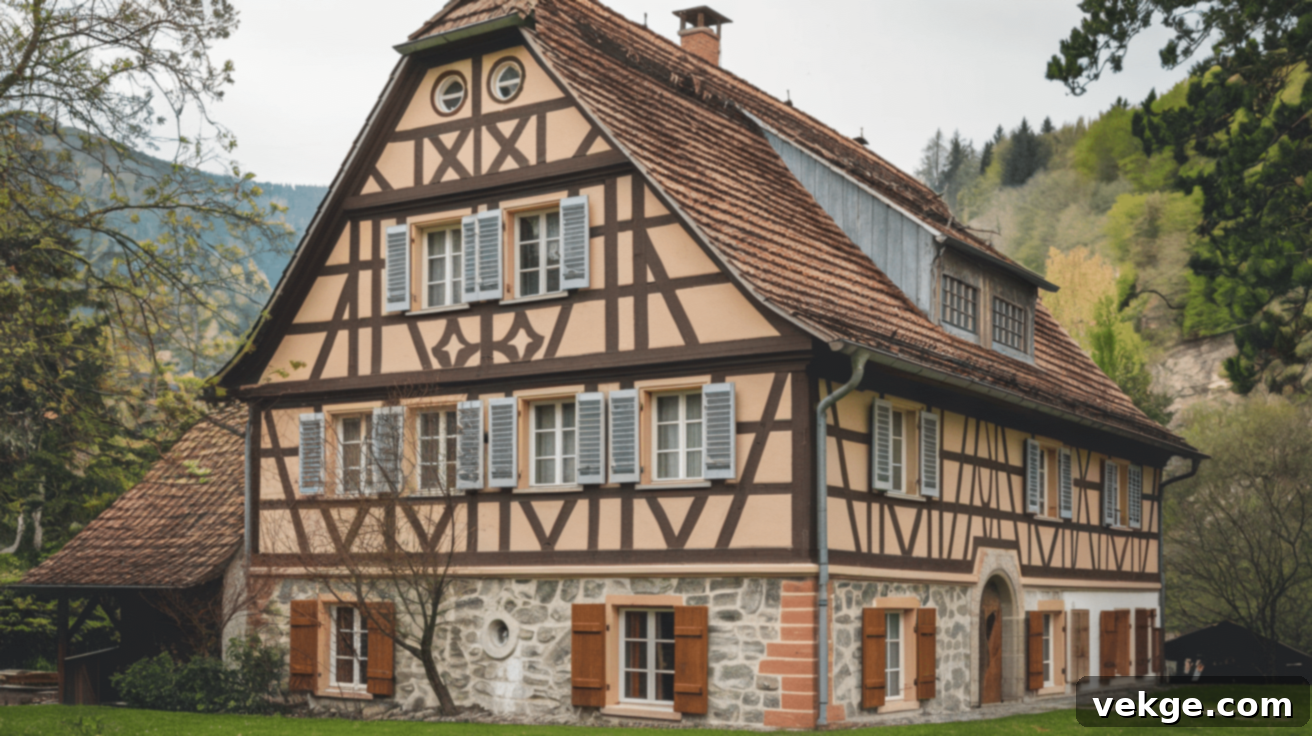German House Styles: A Comprehensive Guide to Architecture, Design, and History
German houses are more than just buildings; they are tangible reflections of the country’s rich history, diverse regional cultures, and innovative approach to living. From the picturesque half-timbered structures of medieval towns to the sleek, energy-efficient marvels of modern cities, German home design offers a captivating blend of tradition and forward-thinking functionality.
The distinctive character of German homes often lies in their thoughtful use of robust, natural materials like wood, brick, and stone, combined with an unwavering commitment to quality and longevity. Some styles transport you back centuries, while others showcase cutting-edge ideas for sustainable and comfortable living in the 21st century.
What truly sets German houses apart on the global stage of home design? This comprehensive guide will explore the main types of German architecture, delve into their defining features, and uncover why they continue to inspire homeowners and architects worldwide. Get ready to embark on a journey through Germany’s architectural landscape and discover how to infuse a touch of German elegance into your own living space.
Types of German-Style Houses
German architectural styles are incredibly diverse, shaped by centuries of history, local resources, and cultural nuances. Let’s explore some of the most prominent and beloved house types that define the German landscape.
1. Half-Timbered Houses (Fachwerkhäuser)
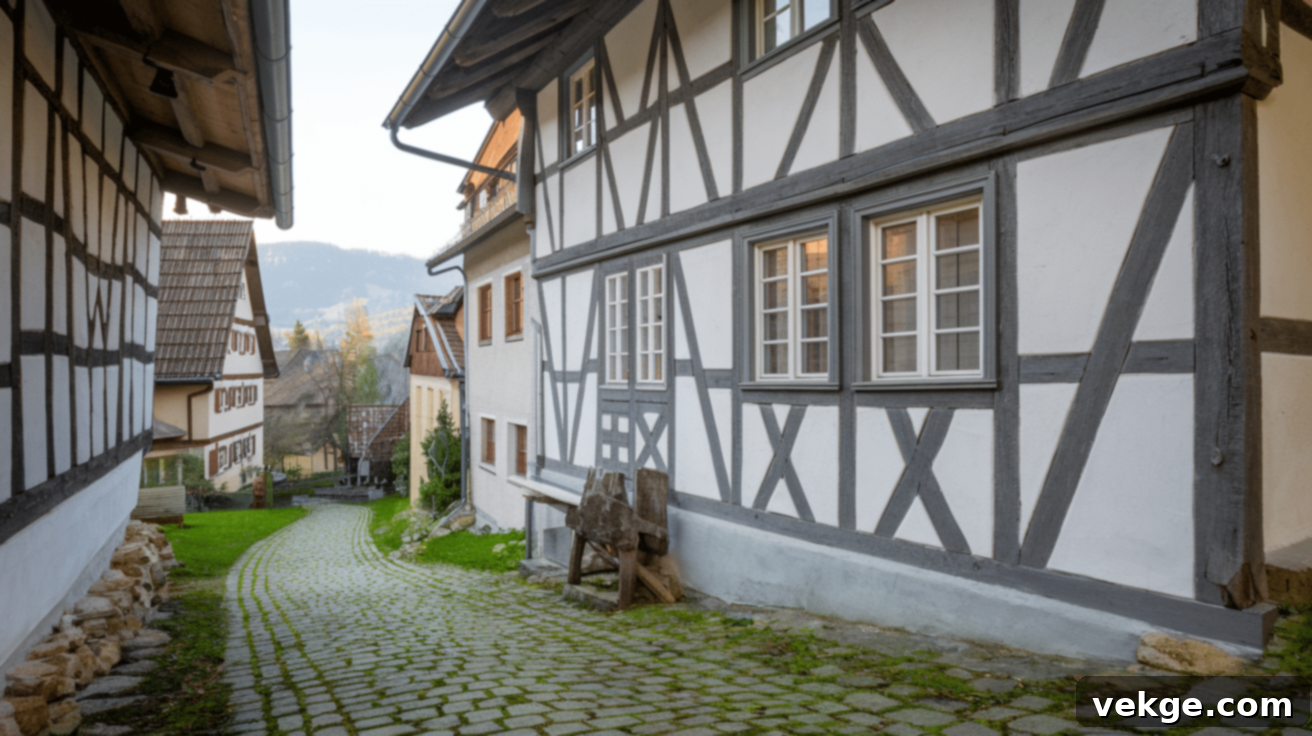
German half-timbered houses, known as Fachwerkhäuser, are truly living history books. These iconic homes, dating back to the medieval period, are characterized by their exposed wooden frameworks filled with infill materials such as brick, stone, or plaster. Each visible wooden beam tells a story of meticulous craftsmanship and enduring tradition.
The intricate wooden frame creates striking patterns on the exterior, often with decorative elements and bracing. Master builders of old would meticulously craft each wooden beam, frequently joining them together with complex, interlocking joints—eschewing nails in many instances—to create incredibly strong and stable structures. The spaces between these robust beams were then filled with local materials like clay, straw, wattle and daub, or brick, providing insulation and weather protection.
This construction method was not merely about aesthetics; it was a highly intelligent and efficient way to build durable and long-lasting homes. Regional variations are abundant across Germany. In some areas, such as Lower Saxony, you’ll find homes with predominantly dark wooden beams contrasted against bright white plaster. In other regions, like the Black Forest or the Moselle Valley, the infill might showcase natural brick or stone, creating a different textural appeal. These homes are more than just structures; they are treasured pieces of German cultural heritage that continue to stand proudly today, captivating visitors and residents alike.
2. Bavarian Cottages (Alpenhütten & Landhäuser)
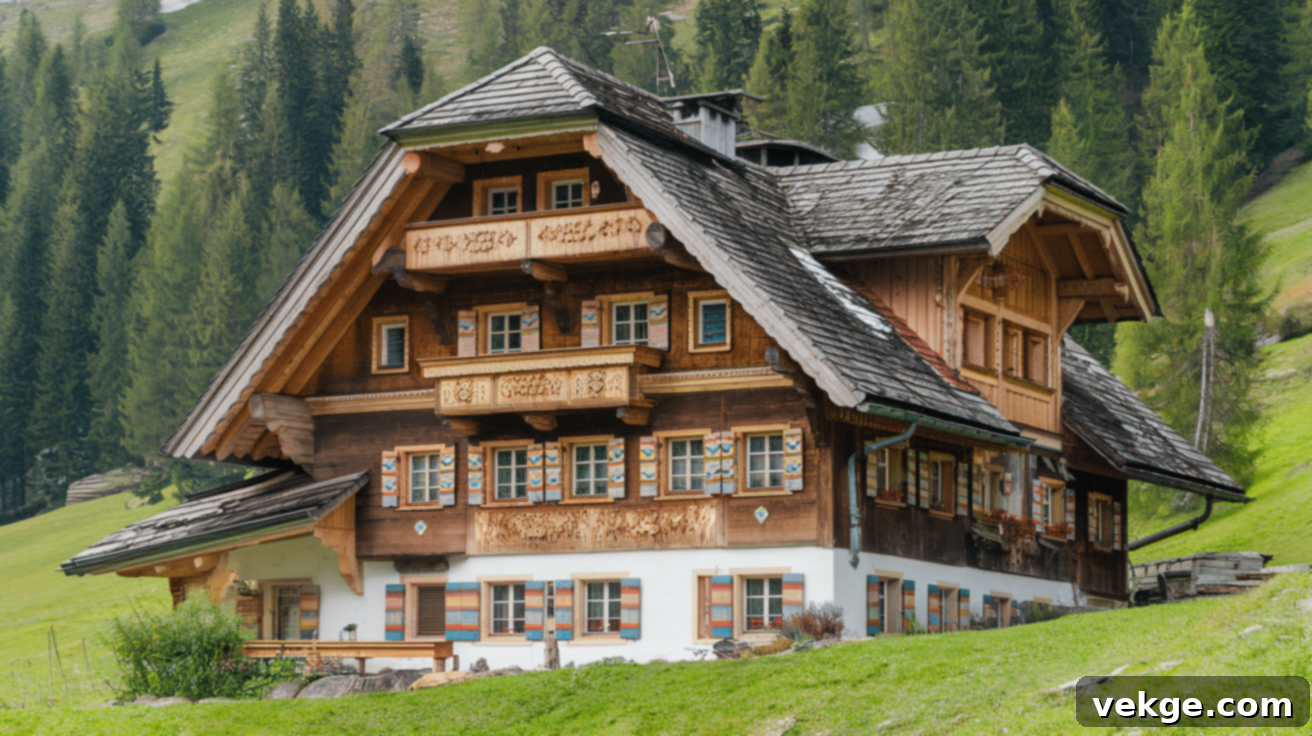
Bavarian homes instantly evoke images of cozy mountain scenes, lush green valleys, and warm family gatherings. Predominantly found in the scenic rural areas of Southern Germany, often with breathtaking Alpine backdrops, these homes are designed to harmonize with their natural surroundings and withstand the region’s climate.
A defining feature of Bavarian cottages is their typically steep, often widely overhanging, gable roofs. This design is crucial for shedding heavy snowfall efficiently during winter months, preventing structural damage. Wood plays a paramount role in Bavarian home design, not only in the structure but also in the rich decorative elements. Intricately carved wooden balconies, often adorned with vibrant flower boxes, and decorative window shutters add immense charm and character. These details, sometimes featuring traditional Bavarian motifs or even delicate fresco paintings (Lüftlmalerei), highlight regional artistry.
The exterior color palettes tend to be warm and natural, featuring soft greens, earthy browns, and crisp whites that beautifully echo the surrounding natural environment. Inside, Bavarian cottages exude a profound sense of warmth and welcome, a concept Germans call Gemütlichkeit. Solid wooden furniture, traditional textiles, and local handicrafts create a comfortable, inviting space that deeply connects families to their roots and the stunning Bavarian countryside. Built-in benches, often around a central dining table, further enhance this communal and cozy atmosphere.
3. Northern German Houses (Backsteinbauten)
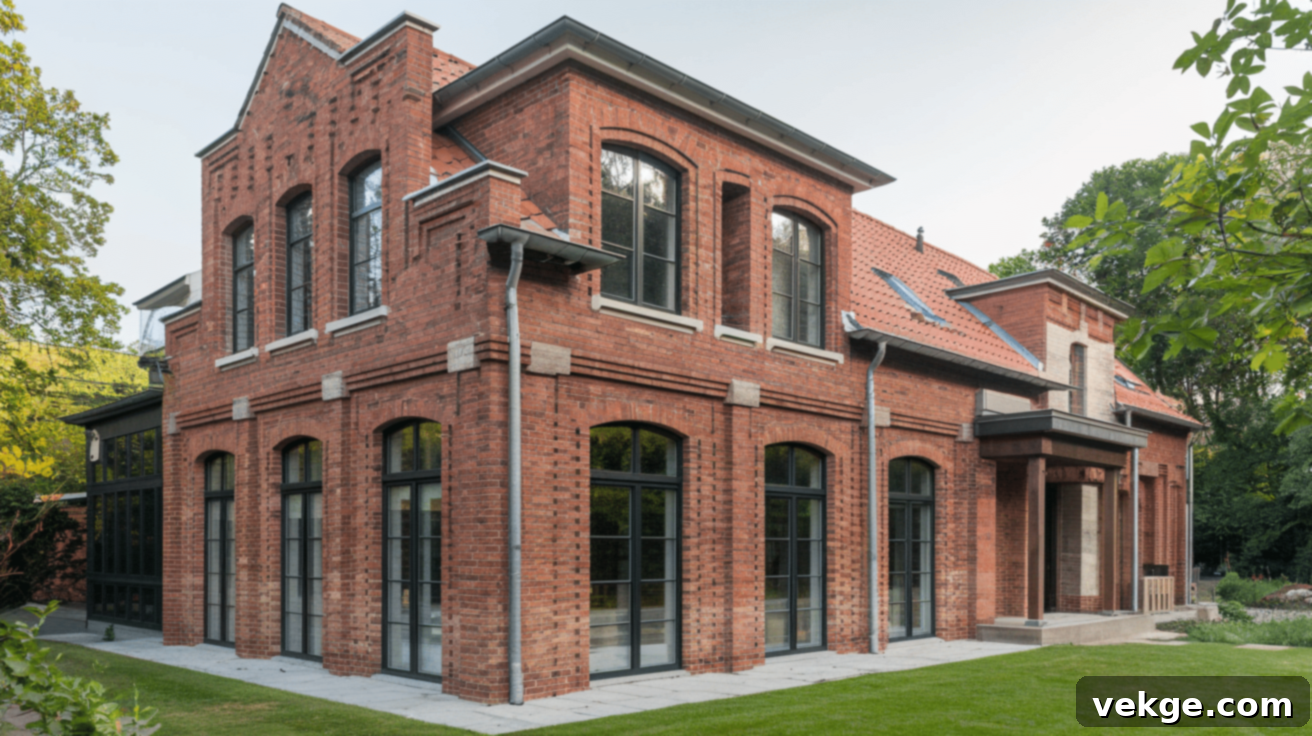
Northern German homes present a distinct architectural approach, where brick takes center stage as the primary building material. Influenced by the Hanseatic League and the availability of clay, these houses often showcase a clean, practical, and robust aesthetic that perfectly reflects the pragmatic nature of northern German culture and the challenging coastal climate.
Deep red brick dominates the exterior of many homes, laid in precise patterns that create visual interest through texture and arrangement rather than elaborate ornamentation. These brick houses, often referred to as Backsteinbauten, range from elegant townhouses to sprawling farmhouses, all unified by their sturdy brick construction. Roofs tend to be simpler and highly functional, typically with a moderate pitch to effectively manage the frequent rain and occasional snow, often featuring impressive stepped gables or crow-stepped gables that add architectural flair.
The design prioritizes comfort, efficiency, and resilience against the elements. Large, often multi-paned windows are common, strategically placed to maximize natural light during shorter winter days. Interiors are designed for warmth and openness, creating welcoming spaces that are both durable and inviting. This regional style, often seen in cities like Hamburg, Bremen, and Lübeck, reflects a long-standing tradition of brick craftsmanship that dates back to the Brick Gothic era.
4. Modern German Homes (Nachhaltige und Minimalistische Bauten)
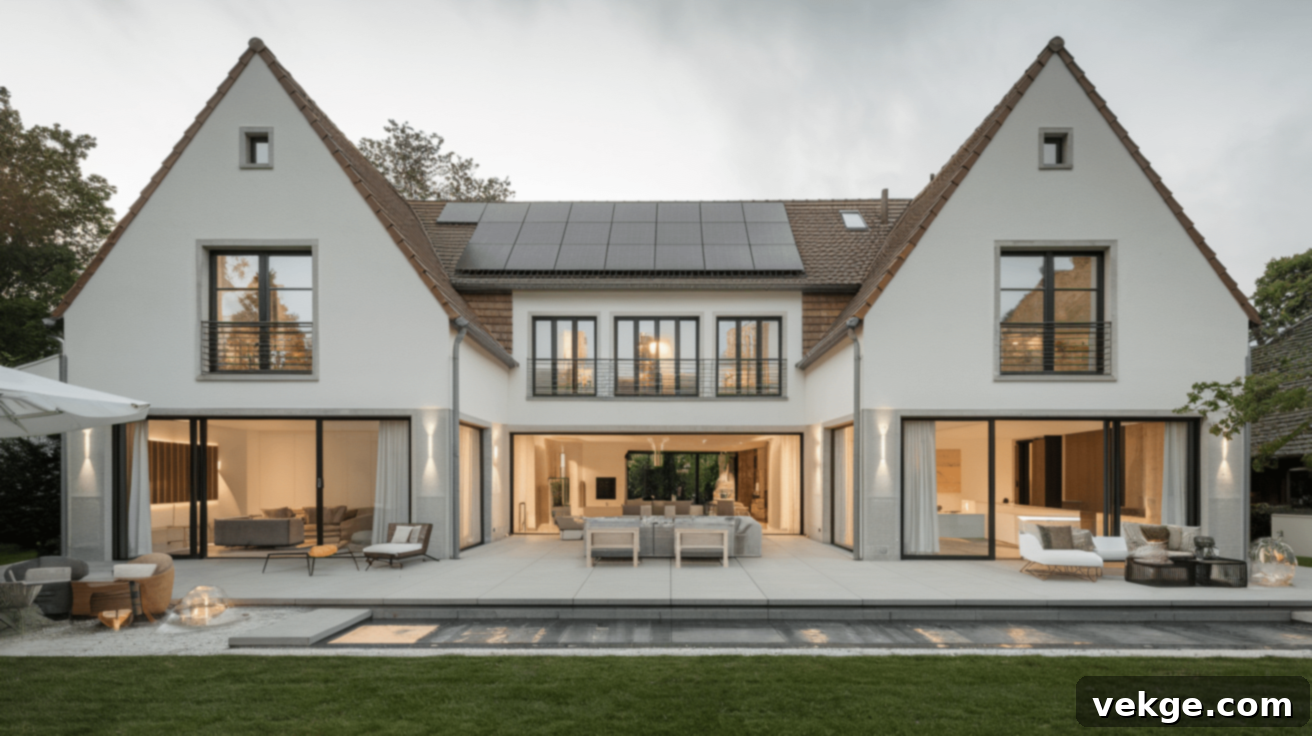
Today’s German homes are a testament to how tradition seamlessly blends with innovation, pushing the boundaries of contemporary design and environmental responsibility. These modern houses prioritize cutting-edge design principles, sustainable construction, and advanced technologies, establishing new benchmarks for smart living.
Energy efficiency is a paramount concern in modern German architecture. Many new builds adhere to stringent “Passivhaus” (Passive House) standards, requiring minimal energy for heating and cooling. This is achieved through superior insulation, airtight construction, high-performance windows, and controlled ventilation systems. Solar panels are a common sight, often integrated discreetly into roof designs, while geothermal heat pumps and smart home systems further reduce energy consumption and environmental impact.
Architecturally, modern German homes feature clean lines, geometric shapes, and often flat or low-pitched roofs. Large windows and expansive open-plan layouts create bright, airy spaces that blur the boundaries between indoor and outdoor living. The interior color palette typically remains neutral—whites, grays, and natural wood tones dominate, creating a calm and sophisticated backdrop. Minimalist design principles ensure that every element serves a purpose, fostering a sense of order and tranquility.
These homes are not just aesthetically pleasing; they are highly functional and forward-thinking, proving that good design can be both beautiful and exceptionally practical, while also being kind to the planet. They represent Germany’s commitment to innovation and sustainable living, often incorporating recycled building materials and local resources.
Key Features of German Style Architecture
Beyond distinct regional styles, certain architectural elements are consistently found in German homes, acting as signature characteristics that define their unique appeal.
Traditional Building Materials
German homes tell a powerful story through their choice of materials, emphasizing durability, local availability, and aesthetic harmony. Wood, brick, and stone are not just components but integral parts of the German architectural identity, each adding its own special touch to the home’s design and character.
Timber framing is a quintessential technique, particularly evident in the Half-Timbered houses (Fachwerkhäuser). The exposed wooden beams, often made from robust oak or fir, create intricate geometric patterns on house exteriors. Historically, builders employed highly skilled joinery techniques, connecting beams with precision-cut mortise and tenon joints that could last for centuries without needing nails. This method allowed for flexible and resilient structures, well-suited to various climates.
Brick adds another layer of character and practicality. Deep red clay bricks often cover home exteriors, especially prominent in northern and eastern Germany. These bricks are laid in careful, often elaborate, patterns that create visual interest through their texture and bond rather than additional ornamentation. Brick offers excellent thermal mass, contributing to energy efficiency, and provides a durable, low-maintenance facade that withstands harsh weather conditions.
Stone also plays a key role, particularly in mountainous regions or as foundational elements. Natural stone foundations provide homes with a solid, grounded feel, while quarry stone or cut stone is used for entire walls, accents, or decorative features. The use of locally sourced stone not only anchors the building visually to its landscape but also contributes to its structural integrity and insulation properties.
Roof Styles
German roofs are far more than mere protection from the elements; they are crucial architectural statements that reflect regional design, climate considerations, and practical needs. The steep pitch is a particularly signature feature of many traditional German homes, designed for maximum efficiency.
Gable roofs dominate the landscape, characterized by their triangular shape formed by two sloping sides meeting at a ridge. These steep roofs are incredibly effective at allowing snow and heavy rain to slide off easily, preventing accumulation and potential structural stress. In regions with harsh winters, such as the Bavarian Alps, the angle of these roofs can be quite dramatic, often reaching 45 to 60 degrees—a significant departure from the flatter roofs seen in drier or warmer climates. This steepness also often creates ample attic space, which historically was used for storage or even converted into additional living areas.
Bavarian homes frequently feature roofs that extend significantly lower on the sides, almost appearing to “hug” the entire house. This design provides enhanced protection to the walls from cold winds and driving snow, contributing to the home’s thermal performance. The broad overhangs also offer shaded areas in summer and protect decorative elements from rain. Beyond gable roofs, variations like hipped roofs (sloping on all four sides) and sometimes mansard roofs can also be found, each adapted to local traditions and functional requirements.
Energy Efficiency and Sustainability
Modern German homes are at the forefront of combining intelligent design with profound environmental consciousness. These houses are prime examples of how comfort and eco-friendliness can not only coexist but thrive together, setting global standards for sustainable living.
Solar panels have become an increasingly common and integrated sight on German roofs, efficiently converting sunlight into electricity and reducing reliance on fossil fuels. Beyond solar PV, solar thermal systems are also widely used for hot water generation. Sophisticated advanced insulation is fundamental, keeping homes exceptionally warm in winter and cool in summer. This superior thermal envelope drastically reduces the need for active heating and cooling, leading to significantly lower energy bills and a reduced carbon footprint.
Smart home technologies are seamlessly integrated to further enhance efficiency and comfort, acting as the silent orchestrators of the home’s environment:
- Automated heating systems learn resident routines and adjust temperatures proactively.
- Smart ventilation systems with heat recovery ensure fresh air circulation while minimizing heat loss.
- High-performance windows, often triple-glazed, help regulate indoor temperature, prevent drafts, and reduce noise.
These integrated systems allow homes to use considerably less energy while maintaining optimal comfort levels for residents, reflecting Germany’s dedication to innovative engineering.
The choice of sustainable materials also makes a substantial difference:
- Utilization of recycled building materials where possible.
- Preference for locally sourced wood from sustainably managed forests.
- Exploration of low-impact concrete alternatives or natural insulation materials like hemp or cellulose.
German architects and builders meticulously consider the entire life cycle of a home—from the sourcing of materials and construction processes to daily living and eventual deconstruction. This holistic approach ensures that modern German homes are not only comfortable and efficient but also active stewards of the environment, proving that thoughtful architecture can truly protect both people and the planet.
The Interior Design of German Homes
German interior design strikes a beautiful balance between timeless tradition and contemporary minimalism, creating spaces that are both inviting and highly functional. It often celebrates natural materials and a serene aesthetic.
Rustic Wooden Furnishings
Wood is undoubtedly the heartbeat of many German-style interiors, particularly in traditional or country homes. These spaces breathe warmth and character through carefully crafted wooden pieces, each often speaking volumes about skilled artistry and a deep connection to nature. This emphasis on natural materials reflects a long-standing appreciation for durability and quality.
- Solid wood tables, often robust and substantial, serve as anchors for living and dining spaces, inviting communal gatherings.
- Chairs with rich wood grains, frequently simple yet elegantly designed, complement these tables, emphasizing comfort and sturdiness.
- Wooden cabinets, sideboards, and shelves showcase expert craftsmanship, providing practical storage solutions while adding aesthetic warmth.
Many of these pieces are not merely furniture but cherished family heirlooms, meticulously maintained and passed down through generations, embodying a sense of heritage and permanence. The use of wood extends beyond movable furnishings:
- Wooden floors, whether wide planks or parquet, create a natural, grounding feel underfoot.
- Exposed wooden beams on ceilings add architectural character and rustic charm, especially in older or more traditional homes.
- The palette of wood tones ranges from light pine and birch to deep, rich oak and walnut, offering diverse aesthetic possibilities.
Each wooden element, from a hand-carved piece to a simple floorboard, tells a story of German forest traditions, skilled woodworking, and a commitment to enduring beauty and functionality.
Minimalist European Style
Modern German homes wholeheartedly embrace a clean, smart, and highly functional design philosophy where less truly becomes more. These carefully planned spaces prioritize order, efficiency, and a serene aesthetic, ensuring every item serves a purpose and nothing feels superfluous.
Neutral color palettes, such as crisp whites, various shades of gray, and soft earth tones, dominate the interior. These colors create calm, expansive, and luminous spaces that feel uncluttered and harmonious. The deliberate absence of excessive ornamentation allows the quality of materials and the functionality of each piece to stand out.
- Furniture typically features clean lines and understated profiles, often sitting low to the ground to enhance a sense of spaciousness.
- Clutter is meticulously hidden away through ingenious storage solutions. Built-in cabinets, smart shelving systems, and multi-functional furniture are crucial for maintaining tidy and organized rooms.
- Large windows are a vital component, maximizing the influx of natural light, which further contributes to the open and airy ambiance.
The core of this minimalist approach is to create peaceful, functional living areas that feel spacious, comfortable, and conducive to relaxation and clarity. It’s a style that values quality over quantity, and thoughtful design over transient trends.
Integration of Modern Technology
In German home design, technology meets tradition in a remarkably seamless and discreet manner. Smart systems operate quietly and efficiently in the background, enhancing daily life without ever dominating the living space or compromising its minimalist aesthetic.
- Heating and cooling systems adjust automatically, often learning family routines and preferences through smart thermostats. They optimize comfort while simultaneously saving energy, demonstrating a core German value of efficiency.
- Solar panels and other energy-efficient appliances are not just add-ons but integrated components of the home’s overall design, reflecting a commitment to sustainability.
- Home assistants and smart speakers are often subtly incorporated into shelves or furniture, designed to blend in rather than stand out.
- Hidden charging stations keep devices powered and cables out of sight, maintaining a clean visual environment.
- Large screens or projectors can disappear into walls or ceilings when not in use, preserving the calm, uncluttered atmosphere.
The overarching goal is simple: make technology genuinely helpful and intuitive without making it the focal point of attention. Control panels are sleek and simple, designed to match the minimalist aesthetic of the home. In essence, technology in a German home serves as an invisible support system, quietly enhancing comfort and efficiency without overwhelming the peaceful and functional living environment.
Regional Variations in German Home Styles
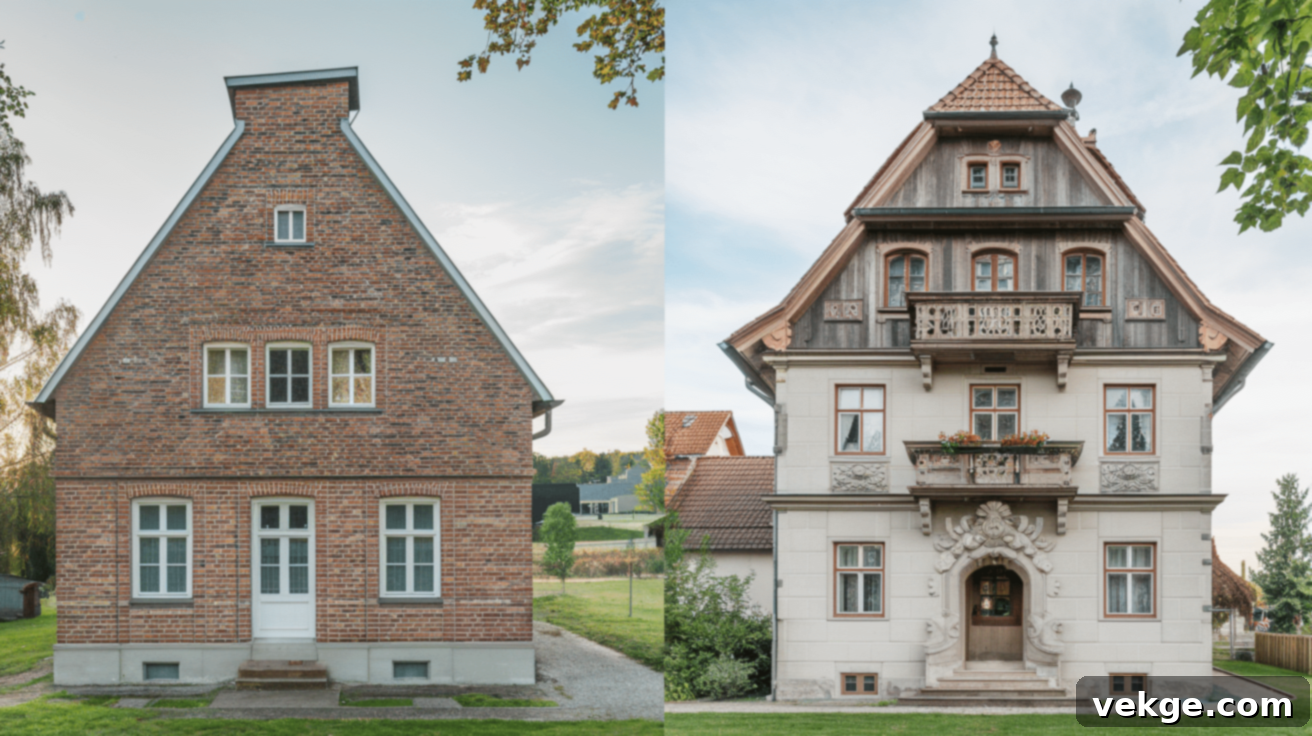
Germany’s rich tapestry of landscapes and historical influences has given rise to distinct architectural styles that vary significantly from one region to another. Understanding these regional differences offers deeper insight into the country’s diverse cultural identity.
Prussian and Eastern German Homes
Homes in Eastern Germany, particularly those influenced by historical Prussia, tell a compelling story of adaptation, resilience, and practical design. This architecture often reflects a robust mix of historical traditions, resource availability, and the pragmatic need to build sturdy homes capable of enduring colder climates. The style often showcases how different regions developed unique living spaces based on their specific conditions.
Brick is frequently the star material in many Prussian-style homes. Red clay bricks cover exteriors in neat, precise patterns, often forming complex bonds that enhance structural integrity and visual appeal. The construction typically focuses on solid, no-nonsense design, built to withstand harsh winters and challenging landscapes. A notable example is the “Mur Pruski” or Prussian wall style (also known as Fachwerk in German), which combines a wooden frame with brick or stone infillings, creating strong and highly efficient homes designed to last for generations.
Architecturally, homes in this region often feature a more angular and somewhat austere look, characterized by sharp roof lines (often hipped or saddle roofs) and clean geometric shapes. This design ethos speaks directly to practicality and efficiency. Large, often multi-paned windows are commonly incorporated to maximize natural light, helping to brighten up the often-gray eastern European skies and contributing to a sense of openness within the sturdy brick shells. This style, while less ornate than some southern counterparts, exudes a timeless dignity and strength.
Southern Germany and Bavarian Homes
Bavarian homes feel as though they have stepped directly out of a storybook, deeply intertwined with the breathtaking Alpine and forest landscapes of Southern Germany. Wooden structures dominate, creating a profoundly warm, rustic, and inviting atmosphere that is synonymous with Bavarian charm.
Steep roofs remain a standout feature, expertly designed to manage the heavy snowfall common in mountainous regions. These roofs often extend significantly lower on the sides, providing crucial protection for the home’s walls from cold winds, driving rain, and snow. Intricately carved wooden balconies, frequently adorned with vibrant flower boxes in summer, add immense charm and character, serving as focal points for the facade.
Color plays a vital role in Bavarian design:
- Soft greens that mirror the lush meadows.
- Warm browns from the abundant timber.
- Crisp whites used for plaster infills or decorative elements.
This palette harmonizes perfectly with the natural surroundings. Decorative window shutters, often painted with traditional motifs, and intricate wood carvings or even fresco-style paintings (Lüftlmalerei) on the facades make each home uniquely captivating and steeped in local artistry.
Inside, these homes prioritize Gemütlichkeit, feeling incredibly cozy and welcoming. Soft textiles, traditional decorative items, robust wooden furniture, and strategically placed large windows create spaces that feel both comfortable and deeply connected to nature. The design reflects a rich Bavarian culture, showcasing a deep respect for tradition, a profound love of craftsmanship, and an unbreakable bond with the local landscape. Each home stands as a proud testament to family, history, and regional pride, embodying the very essence of Alpine living.
How to Incorporate German Design in Your Home
Bringing the essence of German design into your living space doesn’t necessarily require a complete home overhaul. Small, thoughtful changes can effectively capture the spirit of German home style, focusing on functionality, natural materials, and a clean aesthetic. These practical tips will help you add a touch of German flair to your home without breaking the bank.
Wood is Your Best Friend
Embrace wood as a fundamental element to introduce German warmth and authenticity:
- Start with solid wood furniture pieces that proudly display their natural grain and simple, robust construction. Look for sturdy tables, chairs, or shelving units with clean, unpretentious lines.
- Opt for woods like oak, pine, or walnut, which are commonly used in Germany and highlight natural beauty.
- Wooden flooring makes a significant impact. If a full floor replacement isn’t feasible, consider large, high-quality wooden area rugs or natural fiber rugs (like jute or sisal) to bring in a similar warm, organic feel.
- Integrate smaller wooden accents: think wooden picture frames, decorative bowls, or even exposed ceiling beams (or faux beams) for architectural interest.
- Choose furniture with visible, well-crafted wood details to instantly create a German-inspired look that speaks to quality and longevity.
Minimalist Design
Adopt the German appreciation for order and functionality by decluttering and simplifying:
- Clear out the clutter rigorously. German design thrives on open, functional spaces where every item has a purpose and contributes to the overall harmony.
- Choose furniture with purpose and clean lines. Each piece should be both beautiful and highly functional, avoiding anything purely decorative or superfluous.
- Pick a neutral color palette. Whites, grays, and soft earth tones create serene, calm, and spacious environments that are easy on the eye and conducive to relaxation.
- Add smart storage solutions that ingeniously hide away everyday items. Built-in shelves, modular storage units, and multi-functional furniture (like ottomans with storage) are key to keeping rooms tidy and organized, embodying efficiency.
Smart Technology Integration
Incorporate technology thoughtfully, echoing the modern German home’s emphasis on seamless functionality:
- Add smart thermostats that learn your routine, optimizing energy use and comfort without you having to constantly adjust them.
- Look for sleek and hidden charging stations or integrated USB ports in furniture to keep devices powered discreetly.
- Choose home technology that blends into your decor rather than standing out as a focal point. Opt for minimalist designs and neutral colors for smart speakers, hubs, and other devices.
- Consider energy-efficient appliances. Not only do they save money and reduce environmental impact, but their typically clean-lined designs perfectly match German aesthetic principles. Look for kitchen appliances in neutral finishes like stainless steel or matte white/black.
Practical Decorative Touches
Focus on quality over quantity when it comes to decorations, selecting items that have meaning or practical utility:
- Add a few key decorative elements. Carved wooden objects (e.g., small sculptures, traditional toys), simple ceramic pieces, or high-quality traditional textiles (like wool blankets or linen throws) can introduce German charm without over-decorating.
- Prioritize natural light. Large windows are a hallmark of German design. If possible, remove heavy curtains and opt for light, airy window treatments such as sheer blinds, simple roller shades, or no coverings at all, allowing natural light to flood the space.
- Incorporate green plants. Simple potted plants add life and a connection to nature, fitting perfectly with the German appreciation for the outdoors.
- Choose simple, functional light fixtures that provide ample illumination without being overly ornate. Warm, soft lighting can create a welcoming and cozy atmosphere, balancing the minimalist aesthetic.
Create Cozy Corners (Gemütlichkeit)
German homes expertly balance minimalism with a profound sense of warmth and coziness, known as Gemütlichkeit:
- Design a cozy reading nook with a comfortable, simple wooden armchair, a soft throw blanket (perhaps made of wool or linen), and a minimalist wooden side table nearby for a cup of tea.
- Layer textiles strategically. Use throw pillows in natural fabrics, soft blankets draped over sofas, and tasteful rugs to add texture and warmth without creating visual clutter.
- Pay attention to lighting. Beyond general illumination, incorporate dimmer switches, floor lamps, and table lamps with warm-toned bulbs to create pockets of soft, inviting light that enhance relaxation and coziness.
Budget-Friendly Tips
You don’t need a massive budget to incorporate German design elements:
- Thrift stores, antique shops, and online marketplaces can be excellent sources for solid wooden furniture pieces that can be refinished or upcycled.
- Focus on a few key pieces that truly capture the German design spirit, rather than trying to overhaul everything at once.
- DIY projects like painting walls in a neutral tone, decluttering, or even making your own simple wooden shelves can make a big impact.
- The smartest tip is to start small. Replace one piece of furniture at a time, gradually add wooden elements, and slowly declutter your spaces.
Ultimately, German design is about more than just aesthetics; it’s about creating a home that functions exceptionally well, feels profoundly comfortable and welcoming, and fosters a strong connection to your space. With these tips, you can certainly bring a thoughtful and inviting touch of German style to any home, making it both beautiful and highly livable.
Conclusion
German-style houses are magnificent storytellers, each design narrating a unique chapter of history, culture, and innovation. From the intricate craftsmanship of half-timbered houses (Fachwerkhäuser) to the enduring charm of Bavarian cottages nestled in the Alps, and the sleek, sustainable vision of modern German architecture, there is an unparalleled diversity that captivates and inspires.
German architecture consistently offers something for everyone, whether you are drawn to rustic tradition, functional minimalism, or cutting-edge eco-conscious design. It’s a testament to a nation that values quality, durability, and a deep connection to its environment. By understanding these styles, you can find your perfect inspiration, blending traditional elements with modern touches to create a home that is truly unique.
Let your house reflect the core principles of German design: functionality, beauty, and intelligence. Embrace robust materials, clean lines, energy efficiency, and a thoughtful approach to living. Whether you’re planning a renovation or simply looking for ways to enhance your current space, the principles of German design provide a timeless and practical framework.
What’s your favorite German-style house design, and what aspects resonate most with you? Drop a comment below and share your thoughts and inspirations!
